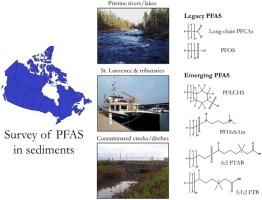Zwitterionic, cationic, and anionic PFAS in freshwater sediments from AFFF-impacted and non-impacted sites of Eastern Canada
IF 12.2
1区 环境科学与生态学
Q1 ENGINEERING, ENVIRONMENTAL
引用次数: 0
Abstract
Zwitterionic, cationic, and anionic per- and polyfluoroalkyl substances (PFAS) were investigated in freshwater sediments of Canada, including sites impacted by aqueous film-forming foams (AFFFs). The first step of the project involved optimizing the extraction method with equilibrated sediment-water-AFFF samples. The analytical method had acceptable linearity, accuracy, and precision in the sediment matrix, and was further validated with NIST SRM 1936. In the second step of the project, the method was applied to determine over 70 target PFAS in field-collected sediments (n = 102). At federal contaminated sites of Ontario, Newfoundland, and Québec (ditches and creeks at international airports with fire training or fire equipment testing areas), summed PFAS averaged 30 ng/g (max of 160 ng/g) with molecular patterns dominated by perfluorooctane sulfonate (maximum PFOS: 84 ng/g). Based on maximum observed concentrations >10 ng/g, other key PFAS at these AFFF-impacted sites included negative ion mode perfluorohexane sulfonate, perfluorohexane sulfonamide, fluorotelomer sulfonates (6:2 FTS and 8:2 FTS) and 5:3 fluorotelomer acid, and positive ion mode N-dimethylammoniopropyl perfluorohexane sulfonamide and 5:1:2 fluorotelomer betaine. In contrast, environmental sediment samples collected at a larger spatial scale (province-wide survey) were characterized by low ΣPFAS (generally <1 ng/g), with PFOS/PFOA below chronic toxicity thresholds for aquatic life.

加拿大东部受 AFFF 影响和未受 AFFF 影响地点淡水沉积物中的齐聚物、阳离子和阴离子 PFAS
对加拿大淡水沉积物(包括受水成膜泡沫(AFFFs)影响的地点)中的齐聚硫离子、阳离子和阴离子全氟和多氟烷基物质(PFAS)进行了调查。项目的第一步是利用平衡沉积物-水-AFFF 样品优化萃取方法。该分析方法在沉积物基质中具有可接受的线性、准确度和精密度,并通过 NIST SRM 1936 进行了进一步验证。在项目的第二阶段,该方法被用于测定现场采集沉积物(n = 102)中的 70 多种目标 PFAS。在安大略省、纽芬兰省和魁北克省的联邦污染区(国际机场的沟渠和小溪,以及消防训练区或消防设备测试区),PFAS 的总和平均为 30 纳克/克(最大值为 160 纳克/克),分子模式以全氟辛烷磺酸为主(最大值为 PFOS:84 纳克/克)。根据观测到的最大浓度>10 纳克/克,这些受 AFFF 影响地点的其他主要 PFAS 包括负离子模式的全氟己烷磺酸盐、全氟己烷磺酰胺、氟橡胶磺酸盐(6:2 FTS 和 8:2 FTS)和 5:3 氟橡胶酸,以及正离子模式的 N-二甲基氨基丙基全氟己烷磺酰胺和 5:1:2 氟橡胶甜菜碱。相比之下,在更大空间范围内采集的环境沉积物样本(全省调查)的ΣPFAS较低(一般为1纳克/克),PFOS/PFOA低于水生生物的慢性毒性阈值。
本文章由计算机程序翻译,如有差异,请以英文原文为准。
求助全文
约1分钟内获得全文
求助全文
来源期刊

Journal of Hazardous Materials
工程技术-工程:环境
CiteScore
25.40
自引率
5.90%
发文量
3059
审稿时长
58 days
期刊介绍:
The Journal of Hazardous Materials serves as a global platform for promoting cutting-edge research in the field of Environmental Science and Engineering. Our publication features a wide range of articles, including full-length research papers, review articles, and perspectives, with the aim of enhancing our understanding of the dangers and risks associated with various materials concerning public health and the environment. It is important to note that the term "environmental contaminants" refers specifically to substances that pose hazardous effects through contamination, while excluding those that do not have such impacts on the environment or human health. Moreover, we emphasize the distinction between wastes and hazardous materials in order to provide further clarity on the scope of the journal. We have a keen interest in exploring specific compounds and microbial agents that have adverse effects on the environment.
 求助内容:
求助内容: 应助结果提醒方式:
应助结果提醒方式:


